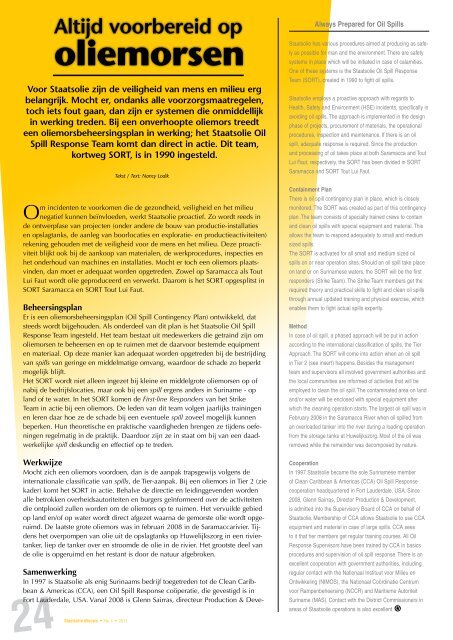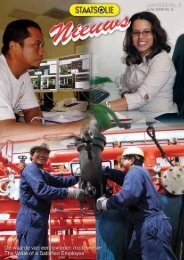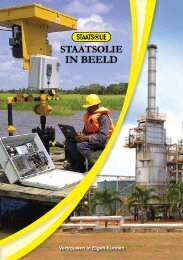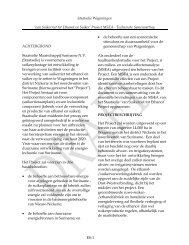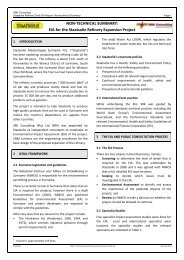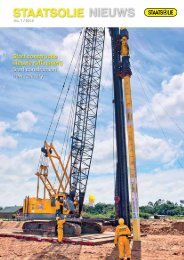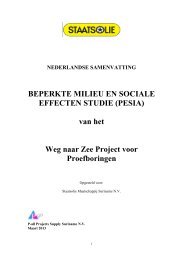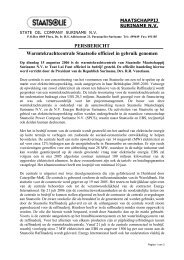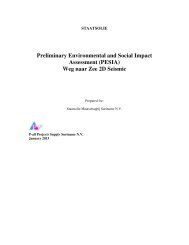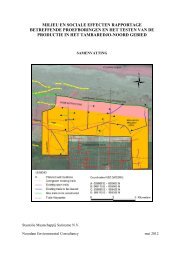staatsolie nieuws
staatsolie nieuws
staatsolie nieuws
You also want an ePaper? Increase the reach of your titles
YUMPU automatically turns print PDFs into web optimized ePapers that Google loves.
Om incidenten te voorkomen die de gezondheid, veiligheid en het milieu<br />
negatief kunnen beïnvloeden, werkt Staatsolie proactief. Zo wordt reeds in<br />
de ontwerpfase van projecten (onder andere de bouw van productie-installaties<br />
en opslagtanks, de aanleg van boorlocaties en exploratie- en productieactiviteiten)<br />
rekening gehouden met de veiligheid voor de mens en het milieu. Deze proactiviteit<br />
blijkt ook bij de aankoop van materialen, de werkprocedures, inspecties en<br />
het onderhoud van machines en installaties. Mocht er toch een oliemors plaatsvinden,<br />
dan moet er adequaat worden opgetreden. Zowel op Saramacca als Tout<br />
Lui Faut wordt olie geproduceerd en verwerkt. Daarom is het SORT opgesplitst in<br />
SORT Saramacca en SORT Tout Lui Faut.<br />
Beheersingsplan<br />
Er is een oliemorsbeheersingsplan (Oil Spill Contingency Plan) ontwikkeld, dat<br />
steeds wordt bijgehouden. Als onderdeel van dit plan is het Staatsolie Oil Spill<br />
Response Team ingesteld. Het team bestaat uit medewerkers die getraind zijn om<br />
oliemorsen te beheersen en op te ruimen met de daarvoor bestemde equipment<br />
en materiaal. Op deze manier kan adequaat worden opgetreden bij de bestrijding<br />
van spills van geringe en middelmatige omvang, waardoor de schade zo beperkt<br />
mogelijk blijft.<br />
Het SORT wordt niet alleen ingezet bij kleine en middelgrote oliemorsen op of<br />
nabij de bedrijfslocaties, maar ook bij een spill ergens anders in Suriname - op<br />
land of te water. In het SORT komen de First-line Responders van het Strike<br />
Team in actie bij een oliemors. De leden van dit team volgen jaarlijks trainingen<br />
en leren daar hoe ze de schade bij een eventuele spill zoveel mogelijk kunnen<br />
beperken. Hun theoretische en praktische vaardigheden brengen ze tijdens oefeningen<br />
regelmatig in de praktijk. Daardoor zijn ze in staat om bij van een daadwerkelijke<br />
spill deskundig en effectief op te treden.<br />
Werkwijze<br />
Mocht zich een oliemors voordoen, dan is de aanpak trapsgewijs volgens de<br />
internationale classificatie van spills, de Tier-aanpak. Bij een oliemors in Tier 2 (zie<br />
kader) komt het SORT in actie. Behalve de directie en leidinggevenden worden<br />
alle betrokken overheidsautoriteiten en burgers geïnformeerd over de activiteiten<br />
die ontplooid zullen worden om de oliemors op te ruimen. Het vervuilde gebied<br />
op land en/of op water wordt direct afgezet waarna de gemorste olie wordt opgeruimd.<br />
De laatste grote oliemors was in februari 2008 in de Saramaccarivier. Tijdens<br />
het overpompen van olie uit de opslagtanks op Huwelijkszorg in een riviertanker,<br />
liep de tanker over en stroomde de olie in de rivier. Het grootste deel van<br />
de olie is opgeruimd en het restant is door de natuur afgebroken.<br />
Samenwerking<br />
In 1997 is Staatsolie als enig Surinaams bedrijf toegetreden tot de Clean Caribbean<br />
& Americas (CCA), een Oil Spill Response coöperatie, die gevestigd is in<br />
Fort Lauderdale, USA. Vanaf 2008 is Glenn Sairras, directeur Production & Deve-<br />
24 Staatsolie<br />
altijd voorbereid op<br />
oliemorsen<br />
Voor Staatsolie zijn de veiligheid van mens en milieu erg<br />
belangrijk. mocht er, ondanks alle voorzorgsmaatregelen,<br />
toch iets fout gaan, dan zijn er systemen die onmiddellijk<br />
in werking treden. Bij een onverhoopte oliemors treedt<br />
een oliemorsbeheersingsplan in werking; het Staatsolie Oil<br />
Spill Response Team komt dan direct in actie. Dit team,<br />
kortweg SORT, is in 1990 ingesteld.<br />
Nieuws • No. 4 • 2011<br />
Tekst / Text: Nancy Lodik<br />
Always Prepared for Oil Spills<br />
Staatsolie has various procedures aimed at producing as safely<br />
as possible for man and the environment. There are safety<br />
systems in place which will be initiated in case of calamities.<br />
One of these systems is the Staatsolie Oil Spill Response<br />
Team (SORT), created in 1990 to fight oil spills.<br />
Staatsolie employs a proactive approach with regards to<br />
Health, Safety and Environment (HSE) incidents, specifically in<br />
avoiding oil spills. The approach is implemented in the design<br />
phase of projects, procurement of materials, the operational<br />
procedures, inspection and maintenance. If there is an oil<br />
spill, adequate response is required. Since the production<br />
and processing of oil takes place at both Saramacca and Tout<br />
Lui Faut, respectively, the SORT has been divided in SORT<br />
Saramacca and SORT Tout Lui Faut.<br />
Containment Plan<br />
There is oil spill contingency plan in place, which is closely<br />
monitored. The SORT was created as part of this contingency<br />
plan. The team consists of specially trained crews to contain<br />
and clean oil spills with special equipment and material. This<br />
allows the team to respond adequately to small and medium<br />
sized spills.<br />
The SORT is activated for all small and medium sized oil<br />
spills on or near operation sites. Should an oil spill take place<br />
on land or on Surinamese waters, the SORT will be the first<br />
responders (Strike Team). The Strike Team members get the<br />
required theory and practical skills to fight and clean oil spills<br />
through annual updated training and physical exercise, which<br />
enables them to fight actual spills expertly.<br />
Method<br />
In case of oil spill, a phased approach will be put in action<br />
according to the international classification of spills, the Tier<br />
Approach. The SORT will come into action when an oil spill<br />
in Tier 2 (see insert) happens. Besides the management<br />
team and supervisors all involved government authorities and<br />
the local communities are informed of activities that will be<br />
employed to clean the oil spill. The contaminated area on land<br />
and/or water will be enclosed with special equipment after<br />
which the cleaning operation starts. The largest oil spill was in<br />
February 2008 in the Saramacca River when oil spilled from<br />
an overloaded tanker into the river during a loading operation<br />
from the storage tanks at Huwelijkszorg. Most of the oil was<br />
removed while the remainder was decomposed by nature.<br />
Cooperation<br />
In 1997 Staatsolie became the sole Surinamese member<br />
of Clean Caribbean & Americas (CCA) Oil Spill Response<br />
cooperation headquartered in Fort Lauderdale, USA. Since<br />
2008, Glenn Sairras, Director Production & Development,<br />
is admitted into the Supervisory Board of CCA on behalf of<br />
Staatsolie. Membership of CCA allows Staatsolie to use CCA<br />
equipment and material in case of large spills. CCA sees<br />
to it that her members get regular training courses. All Oil<br />
Response Supervisors have been trained by CCA in basics<br />
procedures and supervision of oil spill response. There is an<br />
excellent cooperation with government authorities, including<br />
regular contact with the Nationaal Instituut voor Milieu en<br />
Ontwikkeling (NIMOS), the Nationaal Coördinatie Centrum<br />
voor Rampenbeheersing (NCCR) and Maritieme Autoriteit<br />
Suriname (MAS). Contact with the District Commissioners in<br />
areas of Staatsolie operations is also excellent.


